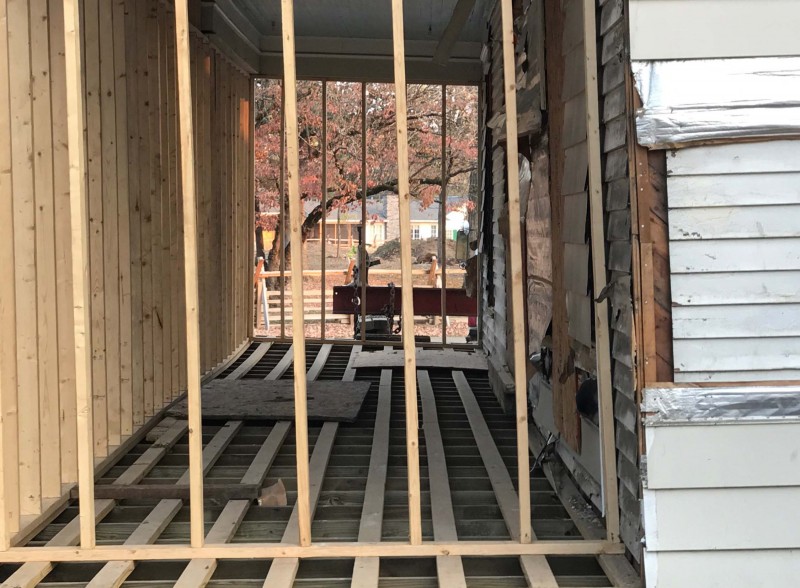At the beginning of the year, the Battle of Franklin Trust had one large hurdle to overcome to achieve the final piece for Carter Hill Battlefield Park.
That came in the form of moving two large houses that formerly contained Franklin Flower and Gift Gallery and the former Williamson County Court Appointed Service Advocates (CASA) office.
The Reid Lovell property came at high price of $2.8 million, but one well-worth it for Battle of Franklin advocates who want to preserve the land where the Union and Confederacy fought one of the bloodiest battles in the Civil War.
Near the end of 2015, American Battlefield Protection Program $1.3 million for Carter Hill Battlefield Park, a 20-acre stretch of land encircling the Carter House. The Battle of Franklin Trust deeded the parcel of land over to the City of Franklin back in March 2016.
Watching to come down piece by piece has been electrifying mixed with a twinge of terrifying for new CASA house owner Rob Anne Legan. She has been living in Franklin for the past 25 years, and plans to move the CASA House to her farm off of Southall Road, about three-quarters of a mile from Halfway Market.
“I have always liked that house,” Legan said. “I had been in it several times before that. I liked the style, and the fact that it was still totally original with the doors and the fireplaces. It’s a beautiful house, and I am interested in preservation.”
This is the first time Legan has done anything like this, but it doesn’t mark the only time a historic enthusiast has picked up a house and moved it off of battlefield property.
Sharon McNeely and her husband, John, had a house moved from its Franklin location in May 2014 to a patch of land 45 minutes down Highway 31 in Lynnville.
The house renovations finished in early 2015 after months of work to bring the 1860s-era home back to its original state. Once a soft blue, the structure used to sit off of Columbia Avenue near Domino’s pizza, which also was removed from battlefield land.
Moving the house became one of the catalysts for the Carter Hill Battlefield Park, a project meant to restore the land that soldiers fought on during the Battle of Franklin.
And moving Legan’s house is becoming one of the closing chapters in the years-long journey to reclaim the parcels of land around the Battle of Franklin trench line where the most fierce fighting took place.

“I think it’s simply marvelous to see this happen,” Franklin’s Charge and Battle of Franklin Trust board member Ernie Bacon said. “Go to the Carter House and look north toward Franklin and look south toward Columbia. Mr. Carter had to have been a smart man to plan and build his home on that knoll. Back in the 1800s, he would have a view. It’s a remarkable achievement and wouldn’t have happened, if not for the efforts of scores of people and a lot of grants.”
The CASA House comes from the 1920s-era, but the former Flower Shop property has a bit of a deeper history. According to Heritage Foundation historian Rick Warwick, the house once sat on the Carter House property. Warwick said in 1896, Col. M.B. Carter traded his farm for one in Triune owned by Mr. Mullins.
“Mullins sold the Carter House and adjoining land soon after to O.E. Daniels of Ohio,” Warwick said. “In 1910 O.E. Daniels sold 3.75 acres south of the Carter House to J.H. Truett for $2,800. In 1911, Truett sold the lot next to the Carter House, to F.B. Brumbach, Jr. for $1,500. In 1919, Brumbach sold to J.H. Porter the lot and new house for $5,500.”
The property later changed hands to tobacco man Asa Jewell for $7,000. During the Jewell family occupancy, the backyard served as a gathering place for local teenagers. In 1956, the Asa Jewell family moved to the Winstead Place, where O’More School of Design is located today. Following the Jewells’ residence, it became the flower and gift shop.
And while the CASA House has found a new place, the former flower shop will become demolished by Ronald Crutcher.
“We went through a detailed process of advertising for any interested parties and all of that,” Bacon said. “It was an exhaustive process that was required by the National Parks Service and the Tennessee Historical Commission. We met all of the requirements and went through that process.”
The CASA house will continue to come down piece-by-piece, with the flower shop demolition scheduled for December.
Emily West covers Franklin, education, and high school football for the Franklin Home Page. Contact her at [email protected]. Follow her on Twitter via @emwest22.



















